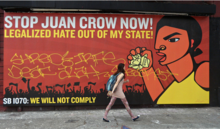Juan Crow

| Part of a series on |
| Chicanos and Mexican Americans |
|---|
 |
Juan Crow is political terminology that was coined by journalist Roberto Lovato.[1][2][3][4][5][6] It first gained popularity when he used it in an article for the Nation magazine in 2008. "Call it Juan Crow: the matrix of laws, social customs, economic institutions and symbolic systems enabling the physical and psychic isolation needed to control and exploit undocumented immigrants."[7] Lovato utilized the term to criticize immigration enforcement laws by analogizing them to Jim Crow laws, and has since become popular among immigration activists.
Laws
The term Juan Crow has been used to refer to immigration enforcement statutes in the United States that penalize illegal immigration and deny services to undocumented people living in the U.S unlawfully.[8][9][10]
Laws in Arizona,[11] Alabama,[8] Georgia,[7] and Texas[12][13] have been considered Juan Crow laws.[who?]
California's Proposition 187 was considered a Juan Crow law by immigration activists. It required citizenship screening of residents and denied social services like health care and public education to undocumented immigrants.[14]
"Juan Crow" as an era
Contemporary historians of Mexican American history use "Juan Crow" as a rough analogue to "Jim Crow", as a way to describe different forms of de facto discrimination experienced by Mexican-Americans in the early 20th century. Max Krochmal writes, "No such formal laws existed regarding Mexicans, but the culture of segregation that emerged similarly sidelined them...all these aspects of Juan Crow were created and enforced by the state...despite the existence of state and local statutes mandating it."[15][16][17]
In the twentieth century Southwest, Mexican Americans were disproportionately poor and positioned at the bottom of employment opportunities.[15] States such as Texas, for example, determined the location and funding of academic buildings, roadways, and services such as running water and sewers, which were of lower quality for disadvantaged, low-income neighborhoods where Mexicans lived.[15] As a result, the inequalities implemented a colonial hierarchy rooted in violence to maintain marginalized people impoverished, vulnerable, and stationed as farm workers. All of this is broadly called "Juan Crow" today.[15]
See also
- Alabama HB 56
- Arizona SB 1070
- California Proposition 187
- Georgia Security and Immigration Compliance Act
References
- ^ Mendoza, José Jorge (2015). "Doing Away with Juan Crow: Two Standards for Just Immigration Reform". APA Newsletter on Hispanic/Latino Issues in Philosophy. 15 (2): 14-20.
- ^ Davila, Arlene (2012). "To stop tip-toeing around race: what Arizona's battle against ethnic studies can teach academics". Identities. 19 (4): 411-417. doi:10.1080/1070289X.2012.699878. S2CID 144194993. Archived from the original on 2022-06-12. Retrieved 2022-06-12.
- ^ Embrick, David G. (2020). "Capitalism, Racism, and Trumpism: Whitelash and the Politics of Oppression". Fast Capitalism. 17 (1): 203–224. doi:10.32855/fcapital.202001.012. Archived from the original on 2022-06-18. Retrieved 2022-06-12.
- ^ Cullison, Jennifer L. (2018). The Growth of Immigrant Caging in Postwar America: National Immigration Policy Choices, Regional Shifts Toward Greater Carceral Control, and Continuing Legal Resistance in the US and South Texas (Phd). University of Colorado at Boulder. Archived from the original on 2022-08-20. Retrieved 2022-08-20.
- ^ Silva, Grant J. (2015). "Why the Struggle Against Coloniality is Paramount to Latin American Philosophy". APA Newsletter on Hispanic/Latino Issues in Philosophy. 15 (1).
- ^ Marquez, Cecilia (2019). "Juan Crow and the Erasure of Blackness in the Latina/o South". Labor. 16 (3): 79–85. doi:10.1215/15476715-7569839. S2CID 204424763. Archived from the original on 2022-08-20. Retrieved 2022-08-20.
- ^ a b Lovato, Roberto (26 May 2008). "Juan Crow in Georgia". The Nation. Archived from the original on 25 October 2020. Retrieved 18 June 2012.
- ^ a b Person, David (November 1, 2011). "'Juan Crow' law alive and well in Alabama". USA Today.
- ^ Cohen, J. Richard (14 June 2008). "Meet "Juan Crow"". Huffington Post. Archived from the original on 3 August 2009. Retrieved 18 June 2012.
- ^ Millan, Claudia (2013). Latining America: Black-Brown Passages and the Coloring of Latino/a Studies (PDF). Athens, Georgia & London: The University of Georgia Press. p. 191. Archived (PDF) from the original on 30 November 2021. Retrieved 7 October 2020.
- ^ Traywick, Catherine. "Juan Crow Laws in Arizona". Campus Progress. Center for American Progress. Archived from the original on 4 January 2011. Retrieved 18 June 2012.
- ^ Gamboa, Suzanne (June 3, 2017). "History of Racism Against Mexican-Americans Clouds Texas Immigration Law". NBC News. Archived from the original on 21 October 2020. Retrieved 7 October 2020.
- ^ Torres, Gerald (June 2006). Law and Class in America - Trends Since the Cold War: The Elusive Goal of Equal Educational Opportunity. New York and London: New York University Press. p. 331. ISBN 978-0814716540. Archived from the original on 5 April 2023. Retrieved 7 October 2020.
- ^ Arellano, Gustavo (2014-09-18). "Republicans used California's 'Juan Crow' law as a model for other states. Now it's dead, and so is the far-right". The Guardian. Guardian News and Media Limited. Archived from the original on 2016-03-23. Retrieved 2016-03-16.
- ^ a b c d Krochmal, Max; Moye, J. Todd (2021). Krochmal, Max (ed.). Civil Rights in Black and Brown: Histories of Resistance and Struggle in Texas. Austin, Texas: University of Texas Press. pp. 4–6.
- ^ Isom Scott, Deena (August 4, 2017). "The New Juan Crow? Unpacking the Links Between Discrimination and Crime for Latinxs". Sage Journals. Archived from the original on April 5, 2023. Retrieved April 5, 2023.
- ^ Martinez, Marlene (October 24, 2019). "Juan Crow". The Measure: An Undergraduate Research Journal. Archived from the original on March 14, 2023. Retrieved March 14, 2023.
